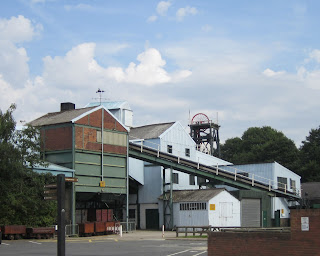In a nutshell
Gauge: 2' 6" and 2' 3"
Length: 750 metres
Opened: 1988
Location:
National Coal Mining Museum for England,
Caphouse Colliery,
New Road,
Overton,
Wakefield
WF4 4RH
View Narrow Gauge Railways in a larger map
Date of visit: 9 September 2012
Key Facts
- The museum was formerly the Caphouse Colliery which dates back to the 1770s
- The timber headgear at Caphouse and the wood framed building at Hope Pit date from between 1905 and 1911
- The colliery closed in 1985, re-opening in 1988 as the Yorkshire Mining Museum
- The museum became the National Coal Mining Museum of England in 1995
- There are free guided underground tours where visitors can experience the working conditions of miners and view their tools and machines
- The visitor centre houses exhibitions including the artwork of former miners
- It is also possible to view the pit-head baths, steam winding house, boiler house, coal screening plant and pit ponies
- A battery powered 2 '6" gauge 'paddy train' takes visitors on a short journey around the park
- There is also a 2' 3" gauge cable (funicular) railway showing how coal tubs were raised from the drift mine
¼ ½ ¾
Route
View National Coal Mining Museum Railways in a larger map
Red = Cable powered funicular railway (2' 3" gauge)
Blue - Battery powered 'Paddy' train (2' 6" gauge)
My Impressions
My first impression was that it was a great pity there were not more people at the museum. There is so much there to see and the museum depicts in good detail what was for many years a key industry in the history of the country. What's more, the café is well stocked and serves a very nice cup of coffee.There was a modest fee (£1.00 return) to travel on the railway and the staff manning the former pit railway were extremely helpful and knowledgeable. The battery powered Bo-Bo locomotive was very powerful and very well turned-out.
We boarded the converted miners' coaches (the roofs of which have been raised to improve comfort for non-mining passengers).
At a sedate pace the train clanked its was across the park .....
.... passing static exhibits of impressive-looking mining machinery.
Before long we arrived at the furthermost terminus of the railway .......
.... where we alighted to explore some of the outdoor exhibits .........
.... such as the pump houses and winding engines.
There are also some intriguing remnants of the past such as this drift mine or adit ......
...... and a scrap yard of former mining equipment which is slowly and sadly rusting into decay.
Returning to the main station, it's possible to explore the main exhibition hall and descend into the mine for an accompanied tour - all of which is free!!
Beside the paddy train is the rope-hauled funicular railway, showing how wagons were extracted from the drift mines in the past. This exhibit wasn't operational when I was there, but the museum has special events during the year when sometimes this railway is working.
What a fascinating place this museum is and on my initial visit I hardly scratched the surface of what can be done and seen. Another visit is certainly on the cards and when one compares what's freely available here with what has to be paid for at other so-called visitor attractions, they bear no comparison.














No comments:
Post a Comment